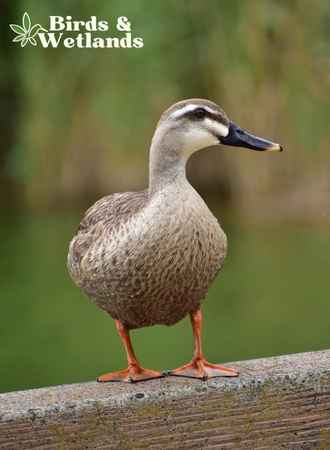Did you know that the bill of a duck, that iconic flat and wide mouthpart, is as versatile a tool as a Swiss army knife? These seemingly simple structures are in fact marvels of natural engineering, helping ducks feed, breathe, and even sense their environment.
But is it accurate to call them beaks? Let’s dive in and find out.
Ducks have bills, not beaks. While the terms ‘beak’ and ‘bill’ are often used interchangeably, the term ‘bill’ is typically used to describe the specialized, elongated mouthpart of certain birds, including ducks. A duck’s bill is broad and flat, designed for dredging and filtering food from water.
Key Takeaways on Duck Bills or Duck Beak
- Duck bills are used for feeding and come in various colors, shapes, and sizes.
- Ducks use their bills to forage and graze in wetlands, as the bill is designed to help them retrieve aquatic plants and small creatures.
- A duck bill is made up of a bony skeleton, which gives it shape and serves a similar purpose to jaws, and a fleshy covering that provides the orange or yellow appearance.
- The bill’s various features, such as the grin patch and lamellae, assist the duck in feeding.
- Ducks are either dabblers, who keep to shallow waters, or divers, who spend more time in deeper water.
- Ducks use their bills to manipulate food and swallow it whole rather than chewing it.
- The exact size and shape of a duck’s bill vary by species, with some bills being more spoon-shaped, which aids in filtering grubs and small fish from water, sand, or mud.
Is There a Difference Between a Beak and a Bill?

The terms ‘beak’ and ‘bill’ often cause a flutter of confusion. They are largely interchangeable, but there are some subtle differences worth noting. ‘Beak’ is typically used when referring to birds with a more pointed and hard structure, such as hawks or eagles, whereas ‘bill’ is often used for waterfowl, like ducks and geese, that have broader and somewhat softer mouthparts.
- Beaks are hardened, pointed structures used for pecking and grasping, while bills are softer, broader structures used for scooping and straining food.
- Beaks are typically found in birds, while bills are also found in some mammals and fish.
- Beaks can vary in size and shape depending on the bird species, while bills often have specialized adaptations for specific feeding behaviors.
- Beaks are usually found in predatory birds like hawks, eagles, and owls, while bills are common in birds that feed on water creatures, such as pigeons, hummingbirds, flamingos, and waders.
Both terms correctly refer to this anatomical feature in various avian species, whether discussing songbirds with slender points or large ducks with fleshy protrusions.
Some people use the term beak to refer to certain birds with a hooked bill and bill to refer to birds with fleshier beaks, such as ducks, geese and other waterfowl species. Both words, however, refer to a wide range of species.
| Parameters of Comparison | Beak | Bill |
|---|---|---|
| Shape | Pointed and rounded ends | Flat and rounded ends |
| Prey | Birds of prey | Birds that do not prey |
| Feeding Habit | Mainly eat meat | Eat water creatures |
| Birds | Hawks, eagles, owls | Pigeons, hummingbirds, flamingos, waders |
| Sharpness | More pointed | Not usually pointed, rounded |
What Do Ducks Have — A Beak or a Bill?
Most people are familiar with their distinctive bill shape when it comes to ducks. Indeed, these unique appendages have become iconic symbols of ducks in popular culture over time.
However, many people are unaware that “beak” also refers to a duck’s bill. In fact, when referring to this mouth-like part of a duck’s anatomy, both terms are frequently used interchangeably.
The mouths of ducks are commonly referred to as “duck bills.” Suppose you compare a duck’s bill to other bird species, such as chickens or toucans. In that case, you might notice some shape, structure, and function similarities.
What Type of Bill Does a Duck Have?
Birds have different bills because they help them adapt to their environment and provide nutrition. These appendages are primarily used for feeding; most birds and other animals have bills based on their eating habits. For example, birds of prey have hooked beaks or hooked bills to rip open flesh. Another example is the bill of finches such as the European Hawfinch which these birds use to open seeds and olive pits.
Many species of ducks require several adaptations to feed efficiently on the water to survive in their aquatic environments. The lamellated bill is one type of bill that is ideal for this purpose. Some have long beaks and others have short ones.
Unlike a typical bill, a lamellated bill has ridges or teeth specially adapted for straining tiny plants and animals out of water. Ducks eat and catch fish using their lamellated bills. They feed on invertebrates, insects, snails, slugs, bugs, grains, seeds, emergent vegetation and other food items. Ducks search for food in shallow waters with their young ones while others dive underwater.
What Is a Duck’s Bill Made Out Of?

The duck’s bill is the only tool this bird needs for feeding but it also serves many functions. Its bill comprises a complex network of different parts and materials. The upper and lower halves of a bill have light bony projections extending from the skull at their core. The bony structure is protected from damage by a sheath made of a tough material called keratin and connected to soft tissues.
The upper surface of the bill has two holes called nares which are used for respiration. It also has densely packed layers of skin cells that help to strengthen it and facilitate movement. In contrast, the lower jaw may be lined with sensory structures that allow ducks to detect pressure changes as they swim. Interestingly, ducks can’t move their upper jaw.
Each side of a duck’s bill has rows of tiny structures of well-developed lamellae (or filtering lamellae), a spatulate shape and digging nails that aid dabbling ducks in grasping food items such as small fish, seeds and insects.
Interestingly, many captive birds need their bills trimmed due to limited opportunities to wear them down naturally.
With its many different components, a duck’s bill plays an important role in helping the bird navigate its environment, feed on prey, and stay healthy.
What are the parts of a duck bill called?
A duck’s bill, also known as a duck’s beak, is a complex structure composed of various parts, each with its own name and function:
- Tip/Nail: The tip of the bill, sometimes called the “nail,” is often a different color than the rest of the bill. This part is used for digging and probing for food in mud or under vegetation.
- Culmen: The culmen is the top ridge of the bill, running from the base of the bill to the tip.
- Mandibles: The upper and lower parts of the bill are called the upper and lower mandibles. The upper mandible is connected to the skull, while the lower mandible can move up and down.
- Tomium: The cutting edge of each mandible is called the tomium. In some species, the tomium can have serrations or other specialized features for specific feeding behaviors.
- Gonys: The gonys is the central ridge on the lower mandible.
- Lamellae: These are comb-like structures on the inside of the bill. They are used for filtering food out of the water, a bit like a built-in strainer.
- Nares: The nares are the nostrils of the bird, located on the upper mandible, usually closer to the base of the bill.
- Rictal Flange: The side or edge of the bill, often flaring out slightly in certain species.
- Bill Sheath: The entire bill is covered with a sheath made of keratin, the same material as human fingernails, which protects the bill and gives it its shape.
Each of these parts plays a vital role in the feeding, survival, and overall life of a duck. For instance, the lamellae help the duck to filter food from the water, while the nares allow the duck to breathe.
What Do Ducks Use Their Bills For?

There are numerous types of ducks, each with its distinct characteristics. Though they have many similarities, one feature that distinguishes these birds is how they use their bills.
Ducks use their bills for hunting and eating. Many ducks have an elongated and flattened bill to help them capture prey in shallow water. Depending on the species, the bill can also have serrated edges to help it scoop up food from the water’s surface.
Most duck bills can aid in filtering food from streambeds as the birds wade through deeper waters.


